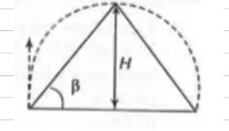It was calculated that a shell when fired from a gun with a certain velocity and at an angle of elevation 5π/36 radius should strike a given target. In actual practice it was found that a hill just intervened in the trajectory. At what angle of elevation should the gun be fired to hit the target ?
5π36radius
7π36radius
11π36radius
13π36radius
The correct Answer is:D
To solve the problem, we need to find the new angle of elevation at which the gun should be fired to hit the target, given that a hill intervenes in the trajectory.
1. Understanding the Initial Condition:
- The initial angle of elevation is given as θ1=5π36 radians. This angle was calculated to hit the target without any obstacles.
2. Identifying the Effect of the Hill:
- The presence of the hill means that the projectile must be fired at a higher angle to ensure it clears the hill and still reaches the target.
3. Using the Concept of Complementary Angles:
- For a given range, there are generally two angles of projection that can achieve the same horizontal distance (range). If one angle is θ, the other angle is 90∘−θ (or π2−θ in radians).
4. Calculating the New Angle:
- Since the original angle of projection is θ1=5π36, the complementary angle (which will be the new angle of projection to hit the target while clearing the hill) is calculated as:
θ2=π2−θ1
- Substituting the value of θ1:
θ2=π2−5π36
5. Finding a Common Denominator:
- To perform the subtraction, convert π2 into a fraction with a denominator of 36:
π2=18π36
- Now substitute this back into the equation for θ2:
θ2=18π36−5π36=(18−5)π36=13π36
6. Conclusion:
- The new angle of elevation at which the gun should be fired to hit the target while clearing the hill is:
θ2=13π36 radians
Final Answer:
The angle of elevation should be 13π36 radians.
---
- The initial angle of elevation is given as θ1=5π36 radians. This angle was calculated to hit the target without any obstacles.
- The presence of the hill means that the projectile must be fired at a higher angle to ensure it clears the hill and still reaches the target.
- For a given range, there are generally two angles of projection that can achieve the same horizontal distance (range). If one angle is θ, the other angle is 90∘−θ (or π2−θ in radians).
- Since the original angle of projection is θ1=5π36, the complementary angle (which will be the new angle of projection to hit the target while clearing the hill) is calculated as:
θ2=π2−θ1
- Substituting the value of θ1:
θ2=π2−5π36
- To perform the subtraction, convert π2 into a fraction with a denominator of 36:
π2=18π36
- Now substitute this back into the equation for θ2:
θ2=18π36−5π36=(18−5)π36=13π36
- The new angle of elevation at which the gun should be fired to hit the target while clearing the hill is:
θ2=13π36 radians
The angle of elevation should be 13π36 radians.
Topper's Solved these Questions
Similar Questions
A gun can shoot a bullet upto a maximum horizontal range R .If the target is at a horizontal distance √3R2, at what elevation angle the gun should be held to hit the target?
View SolutionA shell is fired from a long range gun with an initial velocity u=1000ms−1 at an angle 30∘ to the horizon.How long will the shell be in the air? (g=10.0ms−2)
View Solution
Knowledge Check
- Question 1 - Select One
It was calculated that a shell when fired from a gun with a certain velocity and at an angle of elevation 5π/36 radius should strike a given target. In actual practice it was found that a hill just intervened in the trajectory. At what angle of elevation should the gun be fired to hit the target ?
A5π36RadB11π36RadC7π36RadD13π36Rad - Question 2 - Select One
If the range of a gun which fires a shell with muzzle speed ν is R, then the angle of elevation of the gun is :-
Acos−1(v2Rg)Bcos−1(Rgv2)C12sin−1(v2Rg)D12sin−1(Rgv2) - Question 3 - Select One
If the range of a gun which fires a shell with muzzle speed V is R , then the angle of elevation of the gun is
Acos−1(V2Rg)Bcos−1(gRV2)C12(V2Rg)D12sin−1(gRV2)
A projectile fired from a gun has initial horizontal and vertical components of velocity equal to 30 m/s and 40 m/s, respectively.
What is the speed of the projectile when it is at the highest point in its trajectory?View SolutionA shell fired from the base of a mountain just clears it. If α is the angle of projection, then the angular elevation of the summit β is
 View Solution
View SolutionTwo identical shells are fired from a point on the ground with same muzzle velocity at angle of elevation α=45∘ and β=tan−13 towards top of a cliff, 20m away from the point of firing. If both the shells reach the top simultaneously, then
muzzle velocity isView SolutionTwo identical shells are fired from a point on the ground with same muzzle velocity at angle of elevation α=45∘ and β=tan−13 towards top of a cliff, 20m away from the point of firing. If both the shells reach the top simultaneously, then
height of the cliff isView SolutionTwo identical shells are fired from a point on the ground with same muzzle velocity at angle of elevation α=45∘ and β=tan−13 towards top of a cliff, 20m away from the point of firing. If both the shells reach the top simultaneously, then
time interval between two frings isView Solution

